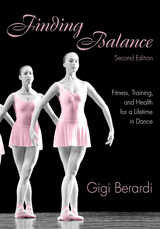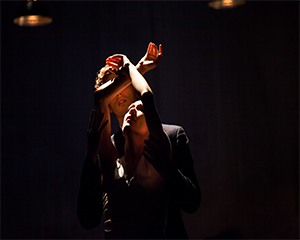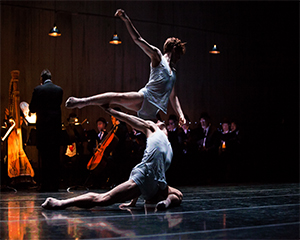We are pleased to have as our guest contributor Gigi Berardi, dance author and critic, who has written over 150 articles and reviews that have appeared in Dance Magazine, Dance International, The Los Angeles Times, among others. She is also a natural and social scientist currently on the faculty of Western Washington University.
Her academic and background and performing experiences allow her to combine her passion for both dance and science Her fifth book, “Finding Balance: Fitness and Training for a Lifetime in Dance” is in its second printing, and is one I highly recommend especially for younger dancers. Gigi’s master degree thesis in dance, from UCLA, focused on older dancers who were able to continue dancing and performing well past the age when most have to retire because of injuries – i.e, what were they doing differently that kept them actively performing into their 50’s, 60’s,70’s? Her current book project is called “A Cultivated Life” — look for it soon!
-Jan Dunn MS, Dance Wellness Editor
______________________________________________________
by Gigi Berardi, MA
How do dancers find balance — literally and figuratively? I feel that the literal part (actually balancing in an unsteady position) is almost the less interesting. As I wrote in the final chapter of the second edition of Finding Balance: Fitness, Training, and Health for a Lifetime in Dance (Routledge, 2005),
The essential information [for] managing a life in dance can be summarized in a handful of principles. Some of those are:
- Practice – in the form of endless repetition of dance movements – does not necessarily make perfect.
- Dancers need to work with limitations, and in so doing, recognize their strengths.
- Being injured is an opportunity to learn and become more sensitive to the warning signs of pain.
- The brain-mind connection is important in learning dance and dances; thus the need for growing neural structures (dendrites), in which visualization techniques can help.
- Learning (and therapy) is most effective with respected teachers (and practitioners) and in supportive environments.
- Certain dietary practices … are counterproductive to long-term weight management (avoiding good, saturated fat; bouts of restrictive eating).
- The science of dance is fraught with controversies …. healthy debate, and multiple interpretations (as is the art of dance); this is another way of saying that there is no one truth, but multiple truths (good and effective practice is often multidisciplinary). However, good ideas and good practices often converge.
In two Seattle performances this winter, I could see such principles in practice:
- practice with a focus on artistry as much as architecture (the number and types of movements)
- a dancer with the flattest feet imaginable dancing handsomely in a principle role (thus, working with limitations)
- dancers who have returned triumphantly from catastrophic injuries
- highly complicated new choreography (expertly danced), but taught with imaging exercises
- working with (well respected) choreographers and ballet masters, and the good working relationship being obvious
- body sizes of all shapes and sorts, indicating a more relaxed attitude of a “company look” (i.e., not sickeningly thin)
- both companies having access to experienced health professionals, who are mighty aware of controversies around and variations of treatment styles.
And, what did I actually see in the performances? Great beauty, focus, and art – from Whim W’him’s season opener Crave More (choreography: Olivier Wevers and Anabelle Ochoa Lopez) to Pacific Northwest Ballet’s Romeo et Juliette (choreography: Jean Christophe Maillot). Dancers in both companies embodied many of the principles I mentioned – showing great control and remarkably imaginative interpretation.
In Lopez’s Crave, guest artist Lucien Postlewaite (former PNB principal and on loan from Les Ballets de Monte Carlo) and Lara Seefeldt danced a moving pas de deux, outrageous for its bold ideas and intimacy. Looking sharp off-balance, the couple maintained a tight bond. Disjointed music added to the jigsaw puzzle of it all. In PNB’s Romeo et Juliette, counterbalance is de rigeur, but therein is also one of the most striking examples of finding one’s center of mass, as given by the principal ballerinas (Kaori Nakamura, Carla Korbes, and Noelani Pantastico). Each Juliette balanced on the balls of her feet in one of the most mesmerizing moments of Act II, balancing for a full 8 bars of music, as she contemplated the faux-poison she was soon to take.
Back to the introduction of this short post, although balance typically is a great physical accomplishment, how much more the psychological balancing, so necessary to be fully the overeager Tybalt, the impetuous Romeo, the strong-willed but also fragile Juliette. But how much also, for Lopez’s dancers in Crave, or Olivier Wevers’ schizophrenic colleague in More (the gorgeous Andrew Bartee), or Wevers’ compelling couples in The Sofa, so present in the strangeness of it all. And as for Ochoa’s brilliant solo piece, the famed Before After, quite simply, there’s nothing like it – which makes it worth seeing again and again for its ferocious and soulful soliloquy – holding true for all the pieces in Wever’s stunning January program.
BIO:

Gigi Berardi holds a MA in dance from UCLA. Her academic background and performing experience allow her to combine her interests in the natural and social sciences with her passion for dance, as both critic and writer. Over 150 articles and reviews by Ms. Berardi have appeared in Dance Magazine, Dance International, the Los Angeles Times, the Anchorage Daily News, The Olympian, The Bellingham Herald, and scientific journals such as BioScience, Human Organization, and Ethics, Place, and Environment. Her total work numbers over 400 print and media pieces. Her public radio features (for KSKA, Anchorage) have been recognized by the Society of Professional Journalists. She has served on the Board of Directors of the Dance Critics Association, and is a member of the American Society of Journalists and Authors, as well as Book Review editor for The Journal of Dance Medicine & Science. A professor at Western Washington University, she received the university’s Diversity Achievement Award in 2004. Her fifth book, Finding Balance: Fitness and Training for a Lifetime in Dance, is in its second printing. Her current book project is titled A Cultivated Life.
Email: Gigi.Berardi@wwu.ed<mailto:Gigi.Berardi@wwu.edu>u
Website: http://myweb.facstaff.wwu.edu/~gberardi and http://www.gigiberardi.com/
Blogs: http://blog.gigiberardi.com/ and http://resilientfarmsnourishingfoods.blogspot.com/







